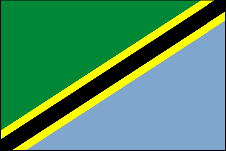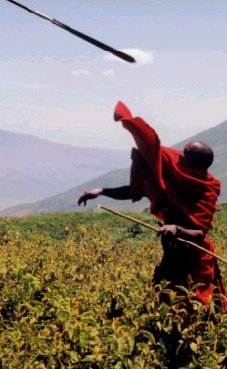

|
History.
The present country of Tanzania came into being in 1964 with the union of Tanganyika
and Zanzibar. There is over 120 tribes on the mainland, most of which migrated from
other pats of Africa. The first Europeans to arrive were the Portuguese, who controlled
most of the coastal region. The Portuguese also controlled Zanzibar until 1699 when
Oman Arabs ousted them from the island. In the late 19th century, along with Rwanda
and Burundi, Tanganyika was absorbed into the colony of German east as a consequence
of a deal between the British and Germans.
Following the German defeat in WW1, the British under successive League of Nations
administered the territory and United Nations mandates. Tanganyika became independent
within the Commonwealth in 1961 after a period of self-government during which the
principal nationalist party, the Tanganyika African National union (TANU), Emerged as
the dominant political force. Its charismatic leader, Julius Nyerere, held the post of
President from independence to 1985. In 1964, Tanganyika joined with Zanzibar and
became Tanzania.
Geography.
The United Republic of Tanzania lies on the Indian Ocean and is bordered by Kenya and
Uganda to the north; Burundi, Rwanda and Democratic Republic of Congo to the west; and
by Zambia, Malawi and Mozambique to the south. The Tanzania main land is divided into
several clearly defined regions the coastal plains, which have lush tropical vegetation,
the Maasai steppe in the north, 200-1000 meters (700-35000 feet) above sea level, and a
high plateau in the south towards Zambia and Lake Nyasa. Savannah and bush cover half
the country, and semi arid desert accounts for the remaining a land area. Volcanic highl
ands can be seen in the northeast and southwest of the country. Over 53,000 square
kilometers is inland water, mostly lakes formed in the Great Rift Valley. The United
Republic of Tanzania includes the island of Zanzibar and Pemba, about 45km (23 miles)
off the coast to the northeast of the country.
Capital City.
Commercial capital: Dar Es Salaam
Administrative capital: Dodoma
Climate.
The climate is tropical and coastal areas are usual hot and humid but regulated by sea
breezes. Average day temperature is 30 degrees centigrade. There are two seasons of
rain in Tanzania: the long rains run from late March until June and the short rains run
from November until January. The long rains fall in heavy downpours, often accompanied
by violent storms. The short rains tend to be much less severe. The hottest time of
the year is December to March, in high altitude areas such as Kilimanjaro or the
Ngorongoro Highlands temperatures can fall below freezing.
Entry Requirements.
A called passport; a valid visa for those not exempted.
Official Languages.
Kiswahili and English.
|
